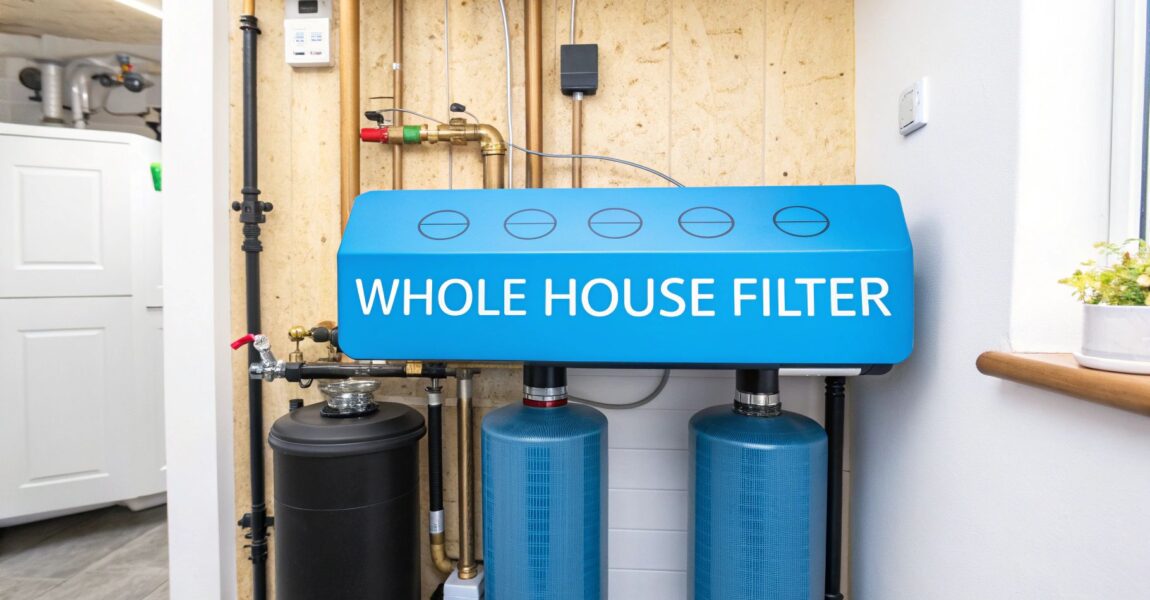
Ever wondered what's really in your tap water? When you start the hunt for the best whole house water filter, you're not just buying an appliance—you're taking control of every drop of water in your home. The top-tier systems all do a few key things brilliantly: they attack contaminants with multiple stages of filtration and are built like tanks to last for years. This isn't just a filter under your sink; it's a full-on water upgrade for your entire house, purifying water from the laundry room to your morning shower.
Your Guide to Pure Water in Every Room
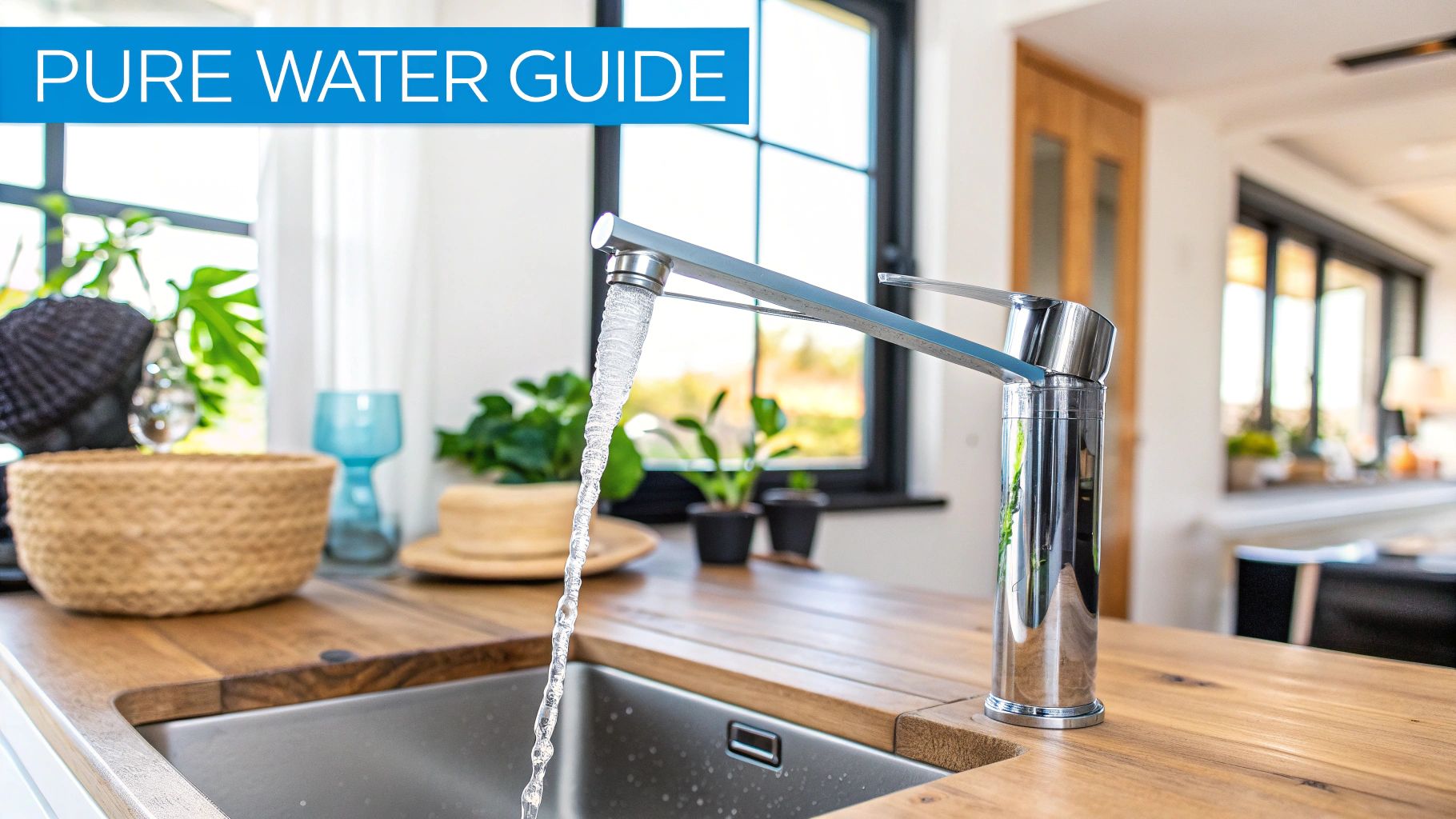
A whole house water filter, also known as a point-of-entry (POE) system, is the ultimate solution for your home's water quality. Forget those clunky pitchers or faucet attachments that only treat water at a single tap. This powerhouse gets installed right where your main water line enters your home.
The result? Every single faucet, showerhead, and water-using appliance—from your washing machine to your dishwasher—gets pristine, filtered water.
Choosing the right system is about more than just banishing a funky taste or smell. It's a serious investment in your family's well-being and the longevity of your home's plumbing. Unseen villains like chlorine, sediment, and heavy metals can wreak havoc on your pipes and force your appliances to work overtime, leading to costly repairs.
Why a Whole Home System is a Game-Changer
Installing a full-scale filtration system delivers benefits you'll feel all over the house. It provides a level of comprehensive protection and convenience that single-point filters simply can't match.
Here are the key perks:
- Healthier Skin and Hair: Say goodbye to the dry, itchy skin and brittle hair that often comes from showering in chlorinated city water. Filtered water is gentler and more nourishing.
- Appliance Lifeguard: Sediment and mineral scale are the arch-nemeses of dishwashers, washing machines, and water heaters. Clean water helps them run efficiently and last much longer.
- Superior Taste and Odor: Finally, you can enjoy crisp, delicious water for drinking and cooking from any faucet in the house. No more stocking up on bottled water.
- Total Peace of Mind: There's a certain confidence that comes with knowing your water is free from a whole host of potential contaminants every time you turn on the tap.
Many homeowners switch to a whole house filter because they're tired of the constant hassle of water treatment. It transforms water quality from a daily chore—refilling pitchers, changing tiny filters—into something that just works, silently and effectively, in the background.
The demand for these systems is surging as more people become aware of what's in their water. The U.S. water purifier market was valued at approximately USD 7.0 billion in 2024 and is projected to climb to USD 10.7 billion by 2033. This boom is fueled by a collective desire for healthier living and incredible advancements in filtration technology, proving just how much homeowners value a reliable, whole-home solution. We'll get into the nitty-gritty of testing your water, comparing different technologies, and finding the perfect system for your needs in the next sections.
Diagnosing Your Home's Water Quality
https://www.youtube.com/embed/fsosGnwhgd4
Before you can choose the right whole house water filter, you have to play detective. What’s actually in your water? Without knowing what you're fighting, you’re just shooting in the dark and might end up with a system that doesn't solve your specific problems.
Your water comes from one of two places: a municipal supply (city water) or a private well. Each source presents a unique cast of potential contaminants, and identifying yours is the most critical first step. This isn't just about making your water taste better; it's about safeguarding your health and your home.
City Water Versus Well Water
If a water bill shows up in your mailbox every month, you're on municipal water. This means a public utility treats the water with chemicals like chlorine or chloramine to kill germs before it reaches you. That's a huge head start on safety, but it leaves behind those treatment chemicals.
On the flip side, if your home has a private well, you are the sole guardian of your water's safety. Well water is far more likely to contain naturally occurring contaminants like sediment, iron, manganese, and even microorganisms like bacteria or viruses, particularly after heavy rain.
The core difference is this: city water is pre-treated for safety but contains disinfection byproducts, while well water is completely untreated and can harbor a much wider range of natural and environmental contaminants. Your filter choice must be tailored to your water source.
Uncovering What's in Your Water
Figuring out the specific chemistry of your water is easier than you might think. The path to answers is quite different depending on where your water originates.
For homeowners on municipal water, your local utility is legally required to provide you with an annual water quality report, often called a Consumer Confidence Report (CCR). This free document is your treasure map, listing detected contaminants and their levels against EPA standards. You can almost always find it on your city’s website.
If you have a private well, testing is your responsibility. While home test strips can give you a basic idea, sending a sample to a state-certified laboratory is the only way to get a truly accurate and detailed analysis. This is non-negotiable for identifying invisible threats like bacteria, nitrates, arsenic, or VOCs.
Common Contaminants and Their Impact
Once you have your report or lab results, you can start identifying the real culprits. Each one affects your water in a different way.
- Chlorine & Chloramine: Used to disinfect city water, these are responsible for the "swimming pool" smell and taste. They also dry out your skin and hair and can cause textiles to fade faster in the laundry.
- Sediment: This is a catch-all term for dirt, sand, rust, and other fine particles. It makes water cloudy, clogs faucet aerators, and can wear down the internal components of your appliances.
- Hardness Minerals (Calcium & Magnesium): The cause of hard water. These minerals leave behind that crusty white limescale on fixtures, kill soap lather, and leave frustrating spots on your clean dishes.
- Heavy Metals (Lead, Iron, Manganese): Lead can leach into water from old plumbing and is a serious health risk. Iron and manganese are common in well water, causing a metallic taste and leaving behind ugly reddish-brown or black stains in sinks, toilets, and on laundry.
- Volatile Organic Compounds (VOCs): These are industrial chemicals and solvents that can seep into the water supply. They're often tasteless and odorless but can have serious long-term health effects.
- Microorganisms (Bacteria, Cysts, Viruses): A major concern for well owners, these can cause gastrointestinal illnesses. Eliminating them requires a specific purification method like a UV light system.
Knowing exactly what's in your water is the first step to fixing it. For coffee lovers, this is a familiar topic; you can see how it applies to brewing in this piece on the most overlooked step in brewing: water quality. Once you know what you need to remove, selecting the right system becomes much clearer.
Comparing Top Water Filtration Technologies
Now that you know what might be lurking in your water, let's meet the technologies designed to take it out. Picking the best whole house water filter isn’t about finding a single "perfect" system. It's about assembling the right team of technologies to tackle your specific water issues. Each filtration method has a distinct specialty, excelling at removing certain contaminants while ignoring others.
This is where we get into the nuts and bolts. Forget the marketing hype for a moment and let's focus on the core technologies that make these systems work. Once you understand how each one functions, its strengths, and its maintenance needs, you can confidently build a solution that’s perfectly matched to your home.
Carbon Filters: The Chemical Sponges
Think of an activated carbon filter as a high-tech chemical sponge. Its surface is incredibly porous, packed with millions of microscopic nooks and crannies. As water flows through, these pores trap chemical contaminants through a process called adsorption.
This makes carbon filters the undisputed champions for improving the taste and smell of city water. They are phenomenal at grabbing chlorine and chloramine—the disinfectants responsible for that "public pool" scent. They also effectively remove a range of VOCs, pesticides, and industrial solvents.
However, carbon filters are not designed to remove sediment, heavy metals, or microorganisms. They are specialists, and their primary mission is to make your water taste and smell fantastic by eliminating specific chemical threats.
Sediment Filters: The Gatekeepers
Often the first line of defense in any whole house setup, a sediment filter is also the simplest. Its job is straightforward: to act as a physical barrier, catching solid particles like dirt, sand, rust, and silt before they can enter the rest of your plumbing.
These filters are rated in microns to indicate how small of a particle they can trap. A 5-micron filter, for example, will stop particles completely invisible to the naked eye.
By removing this debris first, a sediment filter protects the more expensive and sensitive filters downstream. It prevents them from getting clogged, which helps the entire system run more efficiently and last longer. A sediment filter is a non-negotiable component for nearly every setup, especially for homes on well water.
Think of your sediment filter as the bouncer at the club door of your filtration system. It stops the obvious troublemakers from getting inside and causing problems for the more specialized equipment, like your carbon filter or UV purifier.
UV Purifiers: The Microorganism Zappers
Unlike filters that physically trap contaminants, an Ultraviolet (UV) purifier is a sterilizer. It uses a powerful UV-C light lamp to scramble the DNA of living microorganisms, rendering them unable to reproduce and cause illness.
This technology is the gold standard for neutralizing biological threats like bacteria (E. coli, coliform), viruses, and protozoan cysts (Giardia, Cryptosporidium). A UV purifier is an absolute essential for any well water system or for anyone concerned about microbiological safety.
It's crucial to understand that a UV system doesn't remove anything else. It won't change your water's taste, smell, or chemical composition. That’s why it’s almost always paired with sediment and carbon pre-filters—the water must be crystal clear for the UV light to penetrate and work effectively.
This infographic breaks down the ongoing costs and maintenance for these key technologies.
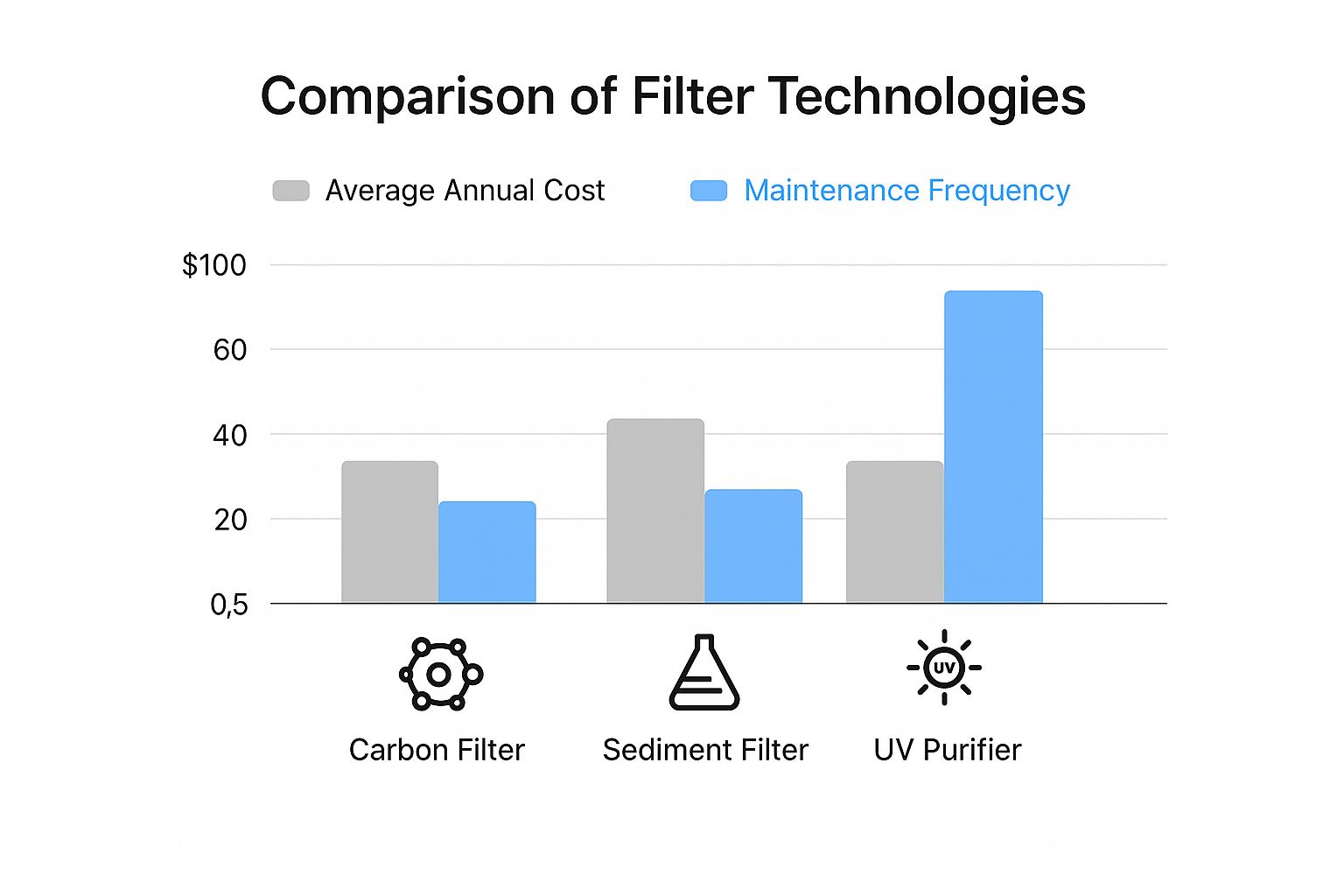
As you can see, while UV purifiers have a higher annual cost due to the lamp replacement, their maintenance is much less frequent than the cartridge-based carbon and sediment filters that need regular swaps.
To make things even clearer, here's a side-by-side comparison of what each technology does best.
Whole House Water Filter Technology Comparison
| Filtration Technology | Removes | Best For | Average Maintenance | Notes |
|---|---|---|---|---|
| Carbon Filter | Chlorine, chloramine, VOCs, pesticides, herbicides, bad taste & odor. | Homes on municipal (city) water to improve taste, smell, and chemical safety. | Cartridge change every 3-12 months. | Doesn't remove minerals, heavy metals, or microbes. Effectiveness depends on the quality of the carbon. |
| Sediment Filter | Dirt, sand, rust, silt, and other suspended solids. | All homes, especially those on well water. Acts as a pre-filter. | Cartridge change every 3-6 months. | Protects other filters from clogging. Micron rating determines the size of particles it can stop. |
| UV Purifier | Bacteria (E. coli), viruses, cysts (Giardia), and other microorganisms. | Homes on well water or anyone concerned with microbiological contamination. | UV lamp change every 12 months. | A sterilizer, not a filter. Requires pre-filtration to ensure water clarity for the UV light to work. |
| Water Softener | "Hardness" minerals like calcium and magnesium. | Homes with hard water issues (limescale, soap scum, appliance damage). | Refill salt every 1-2 months. | Uses ion exchange. Doesn't filter other contaminants but solves major hard water problems. |
This comparison clearly shows how each piece of equipment has a specific, targeted role. Building the ideal system is all about combining them to match your water test results.
Water Softeners: The Mineral Managers
Hard water isn't a health risk, but it's a massive household nuisance. Caused by high levels of dissolved calcium and magnesium, it leads to that crusty limescale buildup on fixtures, soap scum in the shower, and poor appliance performance.
A traditional salt-based water softener solves this problem through a process called ion exchange. It swaps the "hard" mineral ions for "soft" sodium ions, effectively stopping scale formation in its tracks. While it's the most effective way to truly soften water, it does require you to keep it topped up with salt.
The desire for solutions like these is driving massive growth in the home water treatment industry. The global home water filtration market was valued at USD 10.85 billion in 2021 and is expected to reach USD 26.73 billion by 2030, driven by consumers demanding reliable ways to clean their water. Advanced technologies like UV purifiers and multi-stage systems are a big part of that boom. You can explore more data on the home water filtration market if you're interested in the trends.
Understanding these core technologies is the key to building the best whole house water filter for your home. Next, we’ll look at how to combine them into effective systems designed for different real-world scenarios.
Matching a Filter System to Your Home
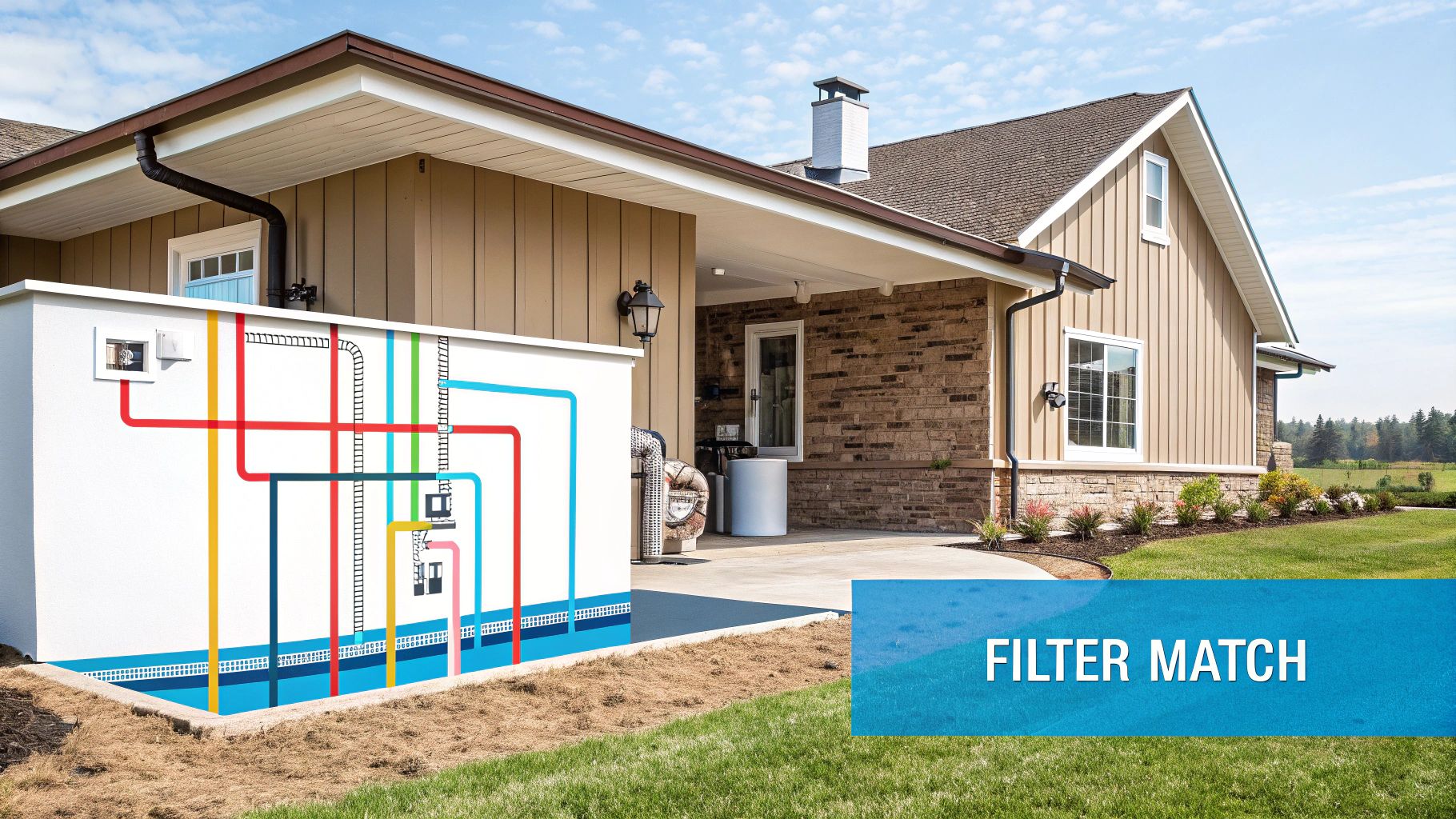
You've got the tech down. Now for the fun part: designing the perfect system for your home. The best whole house water filter is never a one-size-fits-all solution. It’s a customized setup you build based on your water source, your family's size, and the specific contaminants revealed in your water test.
Let's move from theory to practice. We’ll walk through a few common household scenarios to show you how different components come together to solve real-world water problems. See which one sounds most like your situation—it’ll give you a fantastic starting point.
The Urban Home on City Water
If you live in a city or suburb, your water is already treated. The main complaints are almost always the swimming-pool smell of chlorine or the more persistent chloramine. It’s not just about taste; these disinfectants are also known for causing dry skin and brittle hair.
You don't need a complex system here. The goal is to refine the water the city provides.
Recommended System:
- Stage 1 – Sediment Pre-filter: Don't skip this. Even city water can pick up rust and debris from aging municipal pipes. An inexpensive 5-micron sediment filter is crucial for protecting the more expensive carbon filter that follows.
- Stage 2 – High-Capacity Carbon Filter: This is your workhorse. A large catalytic carbon or activated carbon block filter will adsorb the chlorine, chloramine, VOCs, and other chemicals, drastically improving how your water tastes, smells, and feels.
This simple two-stage setup is the perfect, cost-effective solution for the vast majority of homes on municipal water. You'll notice the difference at every single tap.
The Rural Property on Well Water
Well water is a completely different animal. It's raw, untreated groundwater, which means you could be facing a whole cocktail of issues. We're talking sediment, heavy metals like iron and manganese, and the most significant threat: potential microbiological contamination.
For well owners, filtration isn't a luxury; it's a critical safety measure. A robust, multi-stage system is non-negotiable.
Recommended System:
- Stage 1 – Sediment Pre-filter: The absolute first step to catch sand, silt, and rust.
- Stage 2 – Iron & Manganese Filter: If your water test shows these metals, you need a dedicated filter. It uses an oxidizing agent to remove them, preventing ugly stains and that metallic taste.
- Stage 3 – Carbon Filter: This stage takes care of any earthy or organic tastes and odors, plus potential pesticides from nearby agricultural activity.
- Stage 4 – UV Purifier: This is the final, and most critical, line of defense. A UV system zaps bacteria, viruses, and other microorganisms, making the water completely safe to drink.
For anyone on a well, the philosophy is "defense in depth." You have to assume contaminants are present and build a system that can handle sediment, chemical, and biological threats right from the start.
The Household Battling Hard Water
Hard water is an equal-opportunity offender, affecting both city and well water users. If you're fighting a losing battle against limescale on your fixtures, soap scum in the shower, and spotty dishes, your primary focus should be on mineral control.
This leads to a choice: a traditional water softener or a salt-free conditioner. A salt-based softener is the most effective fix for seriously hard water, as it actually removes the hardness minerals. A salt-free conditioner, on the other hand, alters the mineral crystals so they can't stick to surfaces, reducing scale without adding salt to your water.
Recommended Combination:
- For Moderate Hardness: A sediment filter, followed by a salt-free conditioner and then a carbon filter, is a fantastic low-maintenance setup.
- For Severe Hardness: You'll need the heavy artillery. Start with a sediment filter, then a salt-based water softener, and finish with a carbon filter to improve the taste.
This need for customized solutions is a global trend. The whole house water filter market is booming worldwide, driven by different local concerns. In North America, awareness of contaminants is a key driver. In Europe, it’s strict regulations, and in Asia, it's rapid urbanization. This global demand fuels continuous innovation. You can discover more insights about these global water quality trends and see how the market is evolving.
The Health-Conscious Family
For some homeowners, "good enough" isn't good enough. The goal is absolute purity. This is the family that wants to remove the widest possible range of contaminants—chlorine, sediment, heavy metals, fluoride, even trace pharmaceuticals. To achieve this, you need a comprehensive system that covers all the bases.
This is the top-tier approach for ultimate peace of mind.
Recommended System:
- Multi-Stage Filtration: This type of system typically includes a sediment filter, a catalytic carbon filter for chemicals, and a KDF (Kinetic Degradation Fluxion) media filter that specifically targets heavy metals.
- Optional Reverse Osmosis (RO): For the purest drinking water right at the kitchen sink, you can add a point-of-use RO system after the main whole-house unit. This will remove anything left, including dissolved solids, fluoride, and arsenic.
Planning Your Installation and Upkeep
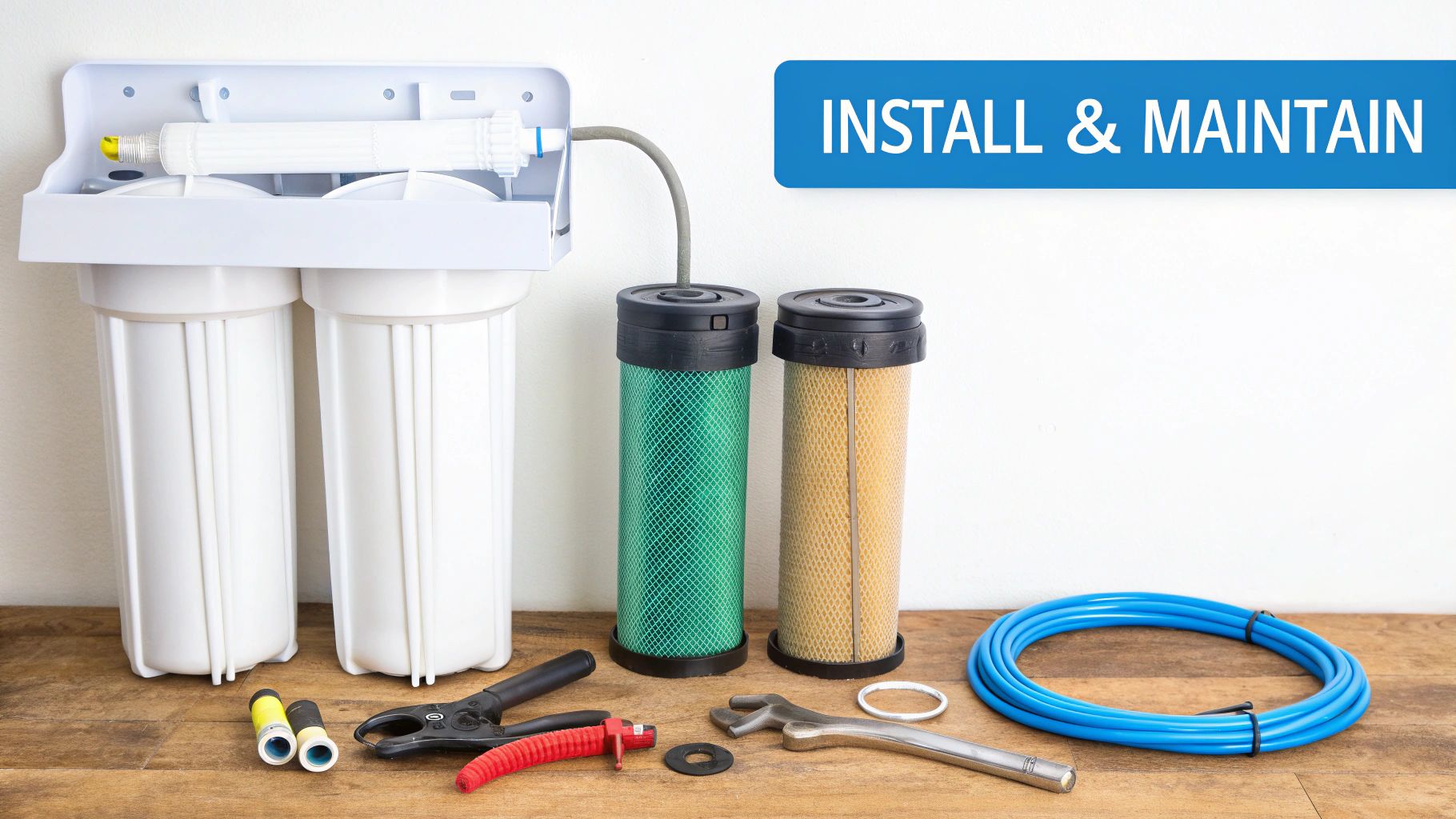
Choosing the right whole house water filter is a huge step, but it’s only half the journey. A fantastic system is only as good as its installation and the ongoing care you provide. This is where a little planning goes a long way, transforming a box on your doorstep into a reliable source of clean water for your entire home.
Before you even make a purchase, create a solid plan for getting the system installed and maintaining it. You’ll need to decide between a DIY installation and calling a pro, and you must look beyond the initial price to understand the true, long-term costs. Getting this right from the start means no unpleasant surprises down the road.
DIY vs. Professional Installation
The first big decision is whether to install the filter yourself or hire a licensed plumber. The DIY route can certainly save you a few hundred dollars in labor costs, but it’s not a project for the faint of heart. You need to be comfortable with basic plumbing, because a single mistake could lead to leaks, water damage, or a filter that simply doesn't work correctly.
Hiring a professional plumber buys you peace of mind. They have the right tools, know the local building codes, and possess the experience to ensure your system is installed for optimal performance and water flow. While it costs more upfront, it's an investment in protecting both your new filter and your home.
If you're leaning toward DIY, make sure you know what you’re getting into. Here’s a quick reality check:
- Essential Skills: You must be comfortable shutting off your home's main water supply and cutting into pipes (whether they're copper, PEX, or PVC). For copper pipes, you'll need soldering skills.
- Necessary Tools: Be prepared with pipe cutters, a couple of good wrenches, a level, and Teflon tape. For copper pipes, a soldering torch and flux are also required.
- Sufficient Space: You need clear access to your main water line with enough room to install the filter unit and any bypass valves without a struggle.
Keep this in mind: A professional installation isn't just for convenience. Many manufacturers will void their warranty if the system isn't installed by a licensed plumber. Suddenly, that DIY savings could become a very expensive gamble.
Calculating the True Cost of Ownership
That initial price tag on the filter? It’s just the beginning. To truly understand the investment, you have to factor in the ongoing maintenance costs that keep the system running effectively. Ignoring these will lead to unexpected bills and, even worse, a filter that eventually stops doing its job.
These predictable, recurring expenses reveal the true cost of the system over its lifetime and should be as important in your decision as the initial purchase price. For a deeper dive into managing your system long-term, you can explore our complete archive of water filter advice.
A Five-Year Maintenance Budget Framework
To give you a clearer picture, let's break down the common long-term costs. Thinking about these expenses over a five-year window will give you a realistic idea of the total investment.
Ongoing Expense Breakdown:
- Filter Cartridge Replacements: This will be your most regular expense. Most sediment and carbon filters need to be swapped out every 3 to 12 months. Expect to pay anywhere from $25 to $100 per filter, depending on your system.
- Media Re-bedding: For large tank-style systems (like carbon or oxidizing filters), the filtration media inside needs to be replaced every 5 to 10 years. It’s not frequent, but it's a significant expense when it comes due.
- Water Softener Salt: If your system includes a salt-based softener, you’ll be adding salt every 1 to 2 months. This typically adds up to $100 to $200 per year.
- UV Lamp Replacement: For systems that use a UV purifier to kill bacteria, the lamp must be replaced annually to remain effective. A new lamp usually runs between $70 and $150.
- Electricity Use: It's a small cost, but UV purifiers and softeners with electronic controls do use electricity, so expect a minor increase in your monthly bill.
By mapping these costs out, you can choose a system that not only solves your water problems but also fits comfortably within your long-term budget.
Your Top Filtration Questions, Answered
As you narrow down your choices for the best whole house water filter, a few practical questions always come up. These are the real-world details that can make or break your experience. Let's get you quick, clear answers to these common sticking points so you can move forward with confidence.
Will a Whole House Water Filter Tank My Water Pressure?
Yes, any filter system will introduce some resistance to your plumbing, which can cause a slight drop in water pressure. However, a properly sized and installed system will have such a minimal effect that you likely won't even notice it. The goal is to avoid creating a bottleneck where your water enters the house.
A few factors influence pressure:
- Filter Type: Densely packed filters and clogged sediment filters are the primary culprits for pressure loss.
- System Flow Rate: Measured in gallons per minute (GPM), this is critical. If you choose a system with a GPM rating that's too low for your home, it will struggle to keep up during peak usage, and you’ll feel it when the shower and dishwasher are running simultaneously.
- Pipe Condition: Older pipes with corrosion or scale buildup can worsen any existing pressure issues.
The best way to prevent problems is to select a system with a GPM rating that can handle your family's peak water demand. For most homes, a system rated for 15-20 GPM is more than adequate. Most importantly, nothing maintains strong water pressure better than changing your filters on schedule.
Will This Filter Make My Water Safe to Drink?
This is a critical question, and the honest answer is: it depends entirely on the filter system and your water source. A standard carbon filter is fantastic at removing chlorine and making water taste great, but it will not eliminate microbiological threats like bacteria or viruses.
A filter and a purifier are not the same thing. A filter removes particles and chemicals, while a purifier neutralizes living organisms. For truly safe drinking water from a questionable source, you often need both.
If your primary concern is ensuring your water is microbiologically pure—especially if you're on well water—you absolutely need a dedicated purification stage. This typically means adding a UV purification system after your main filter or choosing a specialized filter certified for cyst and virus removal, such as a sub-micron filter.
Always look for NSF/ANSI certifications. These independent, third-party ratings confirm what a system can actually remove. For example, NSF/ANSI 53 certifies a filter for removing health-related contaminants, while NSF/ANSI 55 is the standard for UV systems. It’s your guarantee that the filter lives up to its claims.
How Do I Know What Size Whole House Water Filter to Buy?
Sizing your system correctly is crucial for performance and satisfaction. It really comes down to two factors: how much water your household uses and how quickly you need it.
First, consider the number of people and bathrooms in your home. A larger family naturally uses more water, so you'll want a system with a higher filter capacity—the total number of gallons a filter can treat before it needs to be replaced.
Second, and more importantly, is the peak flow rate (GPM). You can get a rough estimate by adding up the flow rates of the fixtures you might use at the same time (a shower is about 2.5 GPM, a toilet flush is 2 GPM, a kitchen faucet is 1.5 GPM).
Here's a quick rule of thumb:
- 1-2 Bathroom Homes: A system with a 10-15 GPM flow rate is usually sufficient.
- 3-4+ Bathroom Homes: Look for a 15-25 GPM system to maintain strong pressure everywhere.
Choosing an undersized system is a common mistake that leads to frustration. It's always better to have a little more capacity than you think you need.
At Water Filter Advisor, our mission is to give you the knowledge to find the perfect water filtration solution for your home. We offer in-depth guides, honest reviews, and practical advice to make your decision simple. Explore our resources today to get safer, better-tasting water. Visit us at https://www.waterfilteradvisor.com.
- October 16, 2025
- 0
- Uncategorized
